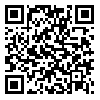Volume 10, Issue 46 (vol. 10, No. 46 2022)
2022, 10(46): 51-60 |
Back to browse issues page
Download citation:
BibTeX | RIS | EndNote | Medlars | ProCite | Reference Manager | RefWorks
Send citation to:



BibTeX | RIS | EndNote | Medlars | ProCite | Reference Manager | RefWorks
Send citation to:
Asadi N, Razavi S M. Physiological and biochemical responses of lettuce plant to the allochemical compound of paraxanthine. Plant Process and Function 2022; 10 (46) : 6
URL: http://jispp.iut.ac.ir/article-1-1522-en.html
URL: http://jispp.iut.ac.ir/article-1-1522-en.html
1- Department of Biology, Faculty of Science, University of Mohaghegh Ardabili, Ardabil, Iran
2- Department of Biology, Faculty of Science, University of Mohaghegh Ardabili, Ardabil, Iran ,razavi694@gmail.com
2- Department of Biology, Faculty of Science, University of Mohaghegh Ardabili, Ardabil, Iran ,
Abstract: (2124 Views)
In this study, the effects of paraxanthin on lettuce were investigated. Paraxanthin is a group of purine alkaloids, secondary metabolites of plants. This compound is made up of the caffeine metabolism found in plants such as tea, coffee and cocoa. There have been previous reports of paraxanthine antihypertensive properties. Three different concentrations of paraxanthine as 10, 50 and 100 µg/ml were treated on lettuce seedlings and then some physiological and biochemical parameters were measured at 7 leave stage of the plants. The results showed that seed germination, radicle and plumule growth of lettuce plant decreased at different concentrations of the paraxanthine in a dose dependent manner. At the concentration of 100µg/ml of paraxanthine, all of the growth parameters were completely inhibited. Some measured parameters such as wet and dry weights of the shoots, photosynthetic rate, photochemical efficiency of photosystem II, leaf relative content and total protein decreased in the paraxanthine treated plants compared to the control group. However, some other parameters such as proline content, hydrogen peroxide and the activity of polyphenol oxidase, ascorbate peroxidase, catalase and protease in the treated plants increased. On the other hand, a significant change in electrophoretic pattern of the plant leaf proteins was observed. Some electrophoretic bands in the treated plants with 100µg/ml of paraxanthine removed in comparison with the control group. The present study demonstrated that the paraxanthine as an allelochemical causes some physiological and biochemical responses in the lettuce which are much similar to those appears under abiotic stress.
Article number: 6
Type of Study: Research |
Subject:
others
Received: 2021/03/23 | Accepted: 2021/06/26 | Published: 2022/02/1
Received: 2021/03/23 | Accepted: 2021/06/26 | Published: 2022/02/1
Send email to the article author
| Rights and permissions | |
 | This work is licensed under a Creative Commons Attribution-NonCommercial 4.0 International License. |







